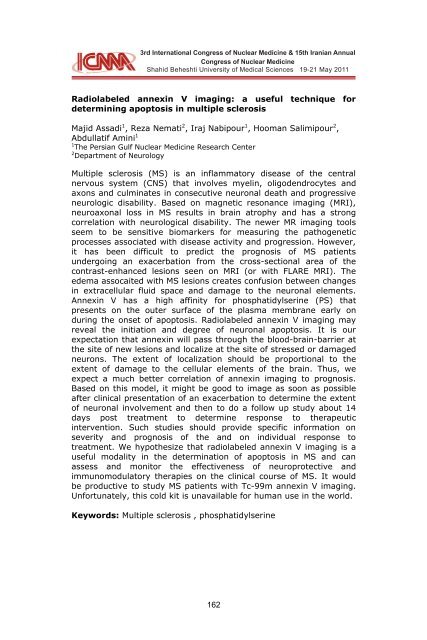Panel Disdussion
Panel Disdussion
Panel Disdussion
Create successful ePaper yourself
Turn your PDF publications into a flip-book with our unique Google optimized e-Paper software.
3rd International Congress 3rd International of Nuclear Congress Medicine of Nuclear & 15th Medicine Iranian Annual & 15th Iranian Congress Annual of<br />
Nuclear Congress Medicine of Nuclear Medicine<br />
Shahid Beheshti Shahid Beheshti University University of Medical Sciences of Medical 19-21 Sciences May 201119-21 May 2011<br />
Radiolabeled annexin V imaging: a useful technique for<br />
determining apoptosis in multiple sclerosis<br />
Majid Assadi 1 , Reza Nemati 2 , Iraj Nabipour 1 , Hooman Salimipour 2 ,<br />
Abdullatif Amini 1<br />
1 The Persian Gulf Nuclear Medicine Research Center<br />
2 Department of Neurology<br />
Multiple sclerosis (MS) is an inflammatory disease of the central<br />
nervous system (CNS) that involves myelin, oligodendrocytes and<br />
axons and culminates in consecutive neuronal death and progressive<br />
neurologic disability. Based on magnetic resonance imaging (MRI),<br />
neuroaxonal loss in MS results in brain atrophy and has a strong<br />
correlation with neurological disability. The newer MR imaging tools<br />
seem to be sensitive biomarkers for measuring the pathogenetic<br />
processes associated with disease activity and progression. However,<br />
it has been difficult to predict the prognosis of MS patients<br />
undergoing an exacerbation from the cross-sectional area of the<br />
contrast-enhanced lesions seen on MRI (or with FLARE MRI). The<br />
edema assocaited with MS lesions creates confusion between changes<br />
in extracellular fluid space and damage to the neuronal elements.<br />
Annexin V has a high affinity for phosphatidylserine (PS) that<br />
presents on the outer surface of the plasma membrane early on<br />
during the onset of apoptosis. Radiolabeled annexin V imaging may<br />
reveal the initiation and degree of neuronal apoptosis. It is our<br />
expectation that annexin will pass through the blood-brain-barrier at<br />
the site of new lesions and localize at the site of stressed or damaged<br />
neurons. The extent of localization should be proportional to the<br />
extent of damage to the cellular elements of the brain. Thus, we<br />
expect a much better correlation of annexin imaging to prognosis.<br />
Based on this model, it might be good to image as soon as possible<br />
after clinical presentation of an exacerbation to determine the extent<br />
of neuronal involvement and then to do a follow up study about 14<br />
days post treatment to determine response to therapeutic<br />
intervention. Such studies should provide specific information on<br />
severity and prognosis of the and on individual response to<br />
treatment. We hypothesize that radiolabeled annexin V imaging is a<br />
useful modality in the determination of apoptosis in MS and can<br />
assess and monitor the effectiveness of neuroprotective and<br />
immunomodulatory therapies on the clinical course of MS. It would<br />
be productive to study MS patients with Tc-99m annexin V imaging.<br />
Unfortunately, this cold kit is unavailable for human use in the world.<br />
Keywords: Multiple sclerosis , phosphatidylserine<br />
162
















